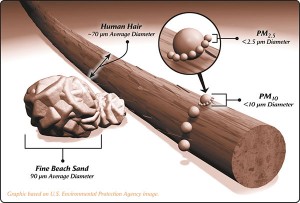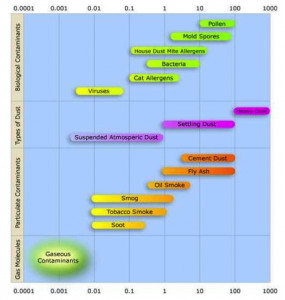Particulate Matter
Particulate matter also known as particle pollution or PM, is the term used to define the course, fine, and ultra fine particles that are in indoor air and is measured in microns (µm). Coarse particles are those that range in size from 2.5 to 10 µm or PM2.5-PM10, and tend to affect the nasal passage, trachea, and bronchi regions of the respiratory system. Fine particles are those that range from PM2.5-PM0.1 and can travel deep within your respiratory system reaching the smallest cavities of the lung, the alveoli. The smallest particle sizes, the ultra fine particles, are those that are smaller than PM0.1. The ultra fine particles are so small in size that they typically remain suspended in the air, and when inhaled, can enter into the blood stream through the respiratory system.
Possible sources of particulate matter indoors include:
Pollution coming from the doors and windows open, exhaust fumes, dust, pollen, dander, feces, soot, tobacco smoke, candles, cooking, wood burning fireplaces, oil lamps, coal stoves, and kerosene lamps.
Harmful Effects:
Prolonged exposure to particulate matter can be a cause behind the increasing morbidity and mortality of humans and is the cause of, or the trigger of respiratory diseases such as asthma and chronic obstructive pulmonary disease. This long-term exposure to particulate matter may give symptoms of irritation, itchy eyes, dizziness, soar throat, coughing, sneezing, laziness, depression, and headaches.




